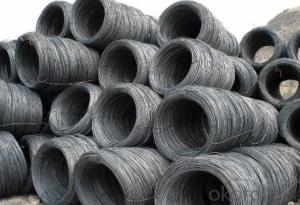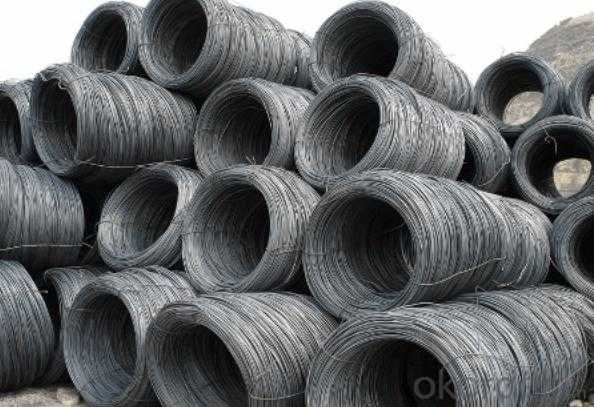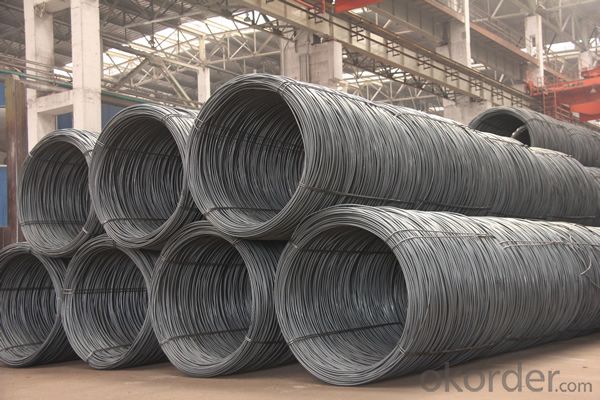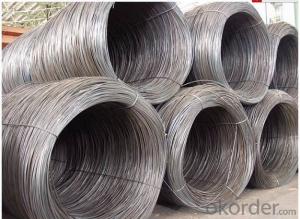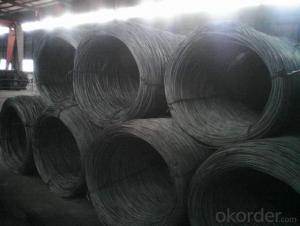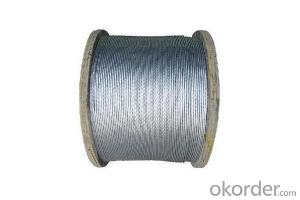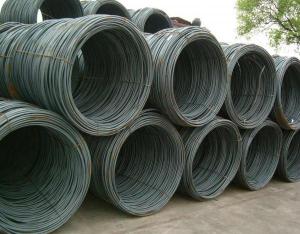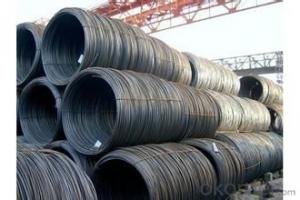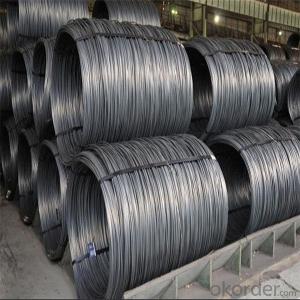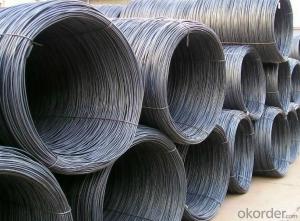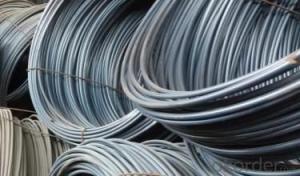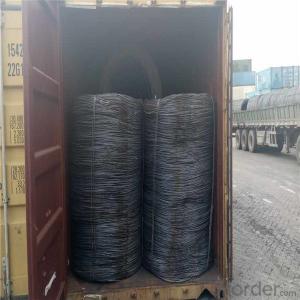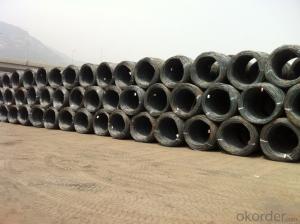Wire Rod 50,000TONS READY STOCK MS Low Carbon Steel Wire Rod
- Loading Port:
- Tianjin
- Payment Terms:
- TT or LC
- Min Order Qty:
- 24 m.t.
- Supply Capability:
- 30000 m.t./month
OKorder Service Pledge
OKorder Financial Service
You Might Also Like
Product Description of Wire Rod 50,000TONS READY STOCK MS Low Carbon Steel Wire Rod:
OKorder is offering Wire Rod 50,000TONS READY STOCK MS Low Carbon Steel Wire Rod at great prices with worldwide shipping. Our supplier is a world-class manufacturer of steel, with our products utilized the world over. OKorder annually supplies products to African, South American and Asian markets. We provide quotations within 24 hours of receiving an inquiry and guarantee competitive prices.
Product Applications of Wire Rod 50,000TONS READY STOCK MS Low Carbon Steel Wire Rod:
Wire Rod 50,000TONS READY STOCK MS Low Carbon Steel Wire Rod are ideal for structural applications and are widely used in construction and manufacturing. Carbon steel wire rod is mainly used for reinforcement of reinforced concrete and welded structure or reprocessed (roberts , nail, etc.) materials, especially used to produce wire drawing, welding electrode, nails, spring, electronic, precise machinery parts and so on.
Product Advantages of Wire Rod 50,000TONS READY STOCK MS Low Carbon Steel Wire Rod:
OKorder's Wire Rod 50,000TONS READY STOCK MS Low Carbon Steel Wire Rod are durable, strong, and wide variety of sizes. They are newly produced by good quality steel billets.
Main Product Features:
· Premium quality
· Prompt delivery & seaworthy packing (30 days after receiving deposit)
· Can be recycled and reused
· Mill test certification
· Professional Service
· Competitive pricing
Product Specifications:
Steel Grade: SAE1006-1018B
Standard: ASTM, GB
Diameter: 5.5mm, 6.5mm, 7mm,8mm,9mm,10mm,12mm,14mm
Type: in coil, coil weight around 2MT
Alloy or Not: Alloy
Technique: Hot Rolled
Place of Origin: China Mainland
Surface: round, no twisted, light and smooth
FAQ:
Q1: Why buy Hot Rolled Low Carbon Steel Wire Rods for Nails, Steel Wire Mesh from OKorder.com?
A1: All products offered byOKorder.com are carefully selected from China's most reliable manufacturing enterprises. Through its ISO certifications, OKorder.com adheres to the highest standards and a commitment to supply chain safety and customer satisfaction.
Q2: How do we guarantee the quality of our products?
A2: We have established an advanced quality management system which conducts strict quality tests at every step, from raw materials to the final product. At the same time, we provide extensive follow-up service assurances as required.
Q3: How soon can we receive the product after purchase?
A3: Within three days of placing an order, we will arrange production. The normal sizes with the normal grade can be produced within one month. The specific shipping date is dependent upon international and government factors, the delivery to international main port about 45-60days.
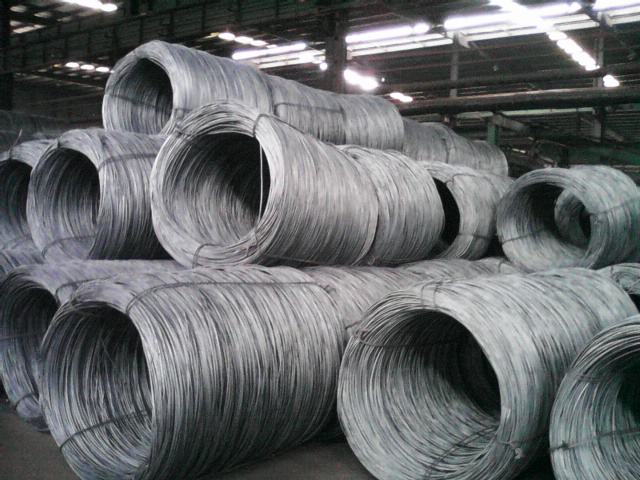
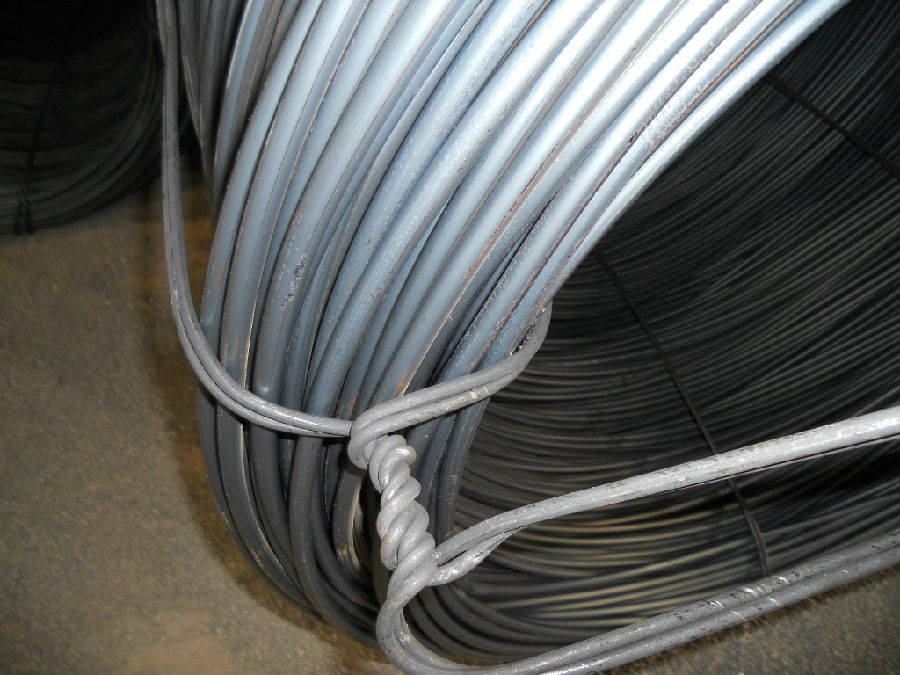
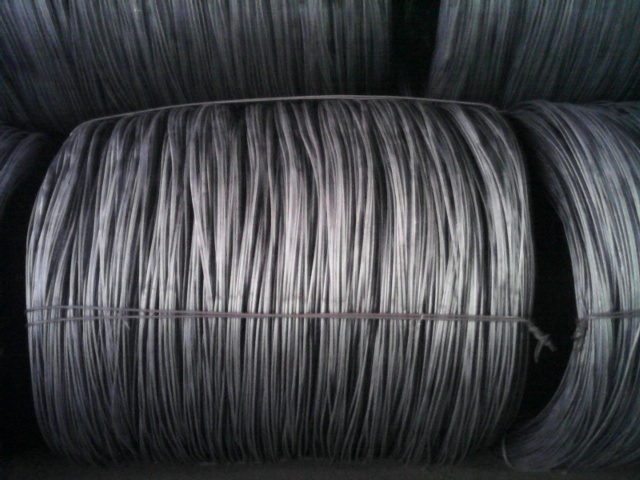
- Q: What are the different types of steel wire rod surface treatments after wire drawing?
- There are several types of steel wire rod surface treatments after wire drawing, including galvanizing, zinc coating, phosphating, and powder coating. These treatments are applied to enhance the wire's corrosion resistance, increase durability, and improve its appearance.
- Q: What are the different cleanliness testing methods for steel wire rod?
- There are several cleanliness testing methods for steel wire rod that are commonly used in the industry. These methods help determine the level of impurities and contaminants present on the surface of the wire rod, ensuring its quality and suitability for various applications. Some of the different cleanliness testing methods for steel wire rod include: 1. Visual Inspection: This is the simplest and most basic cleanliness testing method. It involves a visual examination of the wire rod's surface for any visible impurities such as scale, rust, or foreign particles. 2. Magnetic Particle Inspection (MPI): MPI is a non-destructive testing method that uses magnetic fields and iron particles to detect surface and near-surface defects on the wire rod. It is particularly effective in identifying cracks, seams, or other imperfections that may impact the integrity of the wire rod. 3. Eddy Current Testing: Eddy current testing is another non-destructive method that uses electromagnetic induction to detect surface defects and variations in conductivity. It can identify defects such as cracks, pits, or variations in material composition that can affect the wire rod's quality and performance. 4. Ultrasonic Testing: Ultrasonic testing involves the use of high-frequency sound waves to detect internal and surface defects in the wire rod. It can identify flaws such as voids, inclusions, or discontinuities that may compromise the wire rod's structural integrity. 5. Chemical Analysis: Chemical analysis involves the use of various laboratory techniques to determine the chemical composition of the wire rod. It can identify impurities, such as sulfur, phosphorus, or other elements that may affect the wire rod's mechanical properties and corrosion resistance. 6. Microscopic Examination: Microscopic examination involves the use of optical or electron microscopes to magnify the wire rod's surface and analyze it at a microscopic level. It can help identify surface defects, inclusions, or other anomalies that may affect the wire rod's performance. These different cleanliness testing methods for steel wire rod provide valuable insights into the quality and suitability of the material for its intended use. Manufacturers and end-users can utilize these methods to ensure that the wire rod meets the required cleanliness standards and specifications.
- Q: How is steel wire rod used in the manufacturing of wire forms for window blinds?
- Steel wire rod is used as the primary material in the manufacturing of wire forms for window blinds. It is processed and shaped into various forms such as hooks, brackets, and pulleys, which are essential components of window blind mechanisms. The steel wire rod's strength, durability, and flexibility make it ideal for creating these functional and reliable wire forms that enable smooth operation and adjustment of window blinds.
- Q: What are the common warranty considerations for steel wire rod?
- Some common warranty considerations for steel wire rod include the quality of the material, compliance with industry standards, and the performance of the wire rod for its intended purpose. Other factors may include the durability, strength, and resistance to corrosion of the wire rod. The warranty may also cover any defects in manufacturing or workmanship. It is important to carefully review the terms and conditions of the warranty to understand the specific coverage and any limitations or exclusions.
- Q: How is steel wire rod used in the manufacturing of automotive springs?
- Steel wire rod is used in the manufacturing of automotive springs as it serves as the primary raw material for producing these springs. The wire rods are first shaped and cut into the desired lengths, and then undergo a series of heat treatment processes to enhance their strength and flexibility. These treated wire rods are then coiled and formed into the specific spring shapes required for various automotive applications. The high tensile strength and durability of steel wire rod make it an ideal choice for automotive springs, ensuring reliable suspension and shock absorption in vehicles.
- Q: How is steel wire rod used in the manufacturing of wire forms for automotive seat belts?
- Steel wire rod is a crucial component in the manufacturing of wire forms for automotive seat belts. The wire rod is first processed and shaped into the required form using advanced machinery and techniques. This form is then utilized to create the intricate design and structure of the seat belt, ensuring its strength and durability. Steel wire rod is chosen for this purpose due to its exceptional strength and high tensile properties. It provides the necessary resilience and flexibility required to withstand the stresses and forces experienced by seat belts during normal usage and potential accidents. Once the wire forms are created, they are further processed and treated to enhance their performance characteristics. This may involve heat treatment, galvanization, or coating processes to improve their resistance to corrosion, wear, and tear. The wire forms are then assembled with other components, such as buckles and retractors, to complete the seat belt assembly. The strength and quality of the steel wire rod used significantly contribute to the overall safety and reliability of the seat belt system. In conclusion, steel wire rod plays a vital role in the manufacturing of wire forms for automotive seat belts. It provides the necessary strength, durability, and flexibility to ensure the safety and performance of these critical safety devices.
- Q: What are the common production processes for radium-coated steel wire rod?
- The common production processes for radium-coated steel wire rod typically involve several steps. First, the steel wire rod is cleaned and prepared to ensure its surface is free from any impurities. Then, a layer of radium coating is applied to the wire rod through a process called electroplating or electroless plating. This involves immersing the wire rod in a solution containing radium ions and applying an electric current or using a chemical reaction to deposit the radium onto the surface of the wire rod. After the coating process, the radium-coated wire rod is typically inspected for quality and undergoes any necessary finishing processes, such as cutting, shaping, or heat treatment, depending on its intended application.
- Q: What are the different international standards for steel wire rod?
- There are several international standards for steel wire rod that have been established by various organizations and regulatory bodies. These standards ensure that steel wire rod meets the necessary quality and performance requirements for different applications. Some of the most widely recognized international standards for steel wire rod include: 1. ISO 16120-1:2011 - This standard specifies the general requirements for steel wire rod, including dimensions, tolerances, and mechanical properties. It covers both carbon and alloy steel wire rod. 2. ASTM A510/A510M - This standard is published by the American Society for Testing and Materials (ASTM) and provides the requirements for carbon and alloy steel wire rod. It covers various grades and specifies the chemical composition, mechanical properties, and dimensional tolerances. 3. JIS G 3503 - This Japanese industrial standard defines the requirements for low carbon steel wire rods for general use. It specifies the chemical composition, mechanical properties, and dimensional tolerances. 4. BS EN 10016-2:2017 - This European standard specifies the technical delivery conditions for non-alloy steel wire rod for cold heading and cold extrusion. It covers the chemical composition, mechanical properties, and dimensional tolerances. 5. DIN 17140:1976 - This German standard provides the technical delivery conditions for unalloyed steel wire rod for general purposes. It specifies the chemical composition, mechanical properties, and dimensional tolerances. These international standards serve as guidelines for manufacturers, suppliers, and customers in the steel wire rod industry. They ensure that the product meets the necessary quality standards and can be used reliably in various applications such as automotive, construction, and manufacturing.
- Q: How is steel wire rod used in the manufacturing of wire for solar panels?
- The manufacturing process of wire for solar panels requires steel wire rod, which is carefully selected based on its strength, durability, and conductivity properties. These high-quality wire rods then undergo a series of manufacturing processes to transform them into the necessary wire for solar panels. Initially, the steel wire rod is drawn through a succession of dies to decrease its diameter and increase its length. This wire drawing process is typically carried out using specialized machinery. By repeatedly passing the wire rod through smaller dies, the wire's diameter is reduced while its length is extended. This results in a long and thin wire that is ideal for solar panel applications. Once the wire has been drawn to the desired diameter, it goes through various treatments to enhance its performance and suitability for solar panels. These treatments may involve processes like annealing, where the wire is heated to high temperatures and then gradually cooled. Annealing improves the wire's flexibility, strength, and electrical conductivity. Following the treatment, the wire is meticulously inspected for any defects or imperfections. This quality control step is crucial in meeting the stringent requirements of the solar panel industry. Wires that fail to meet the necessary standards are discarded, while those that pass the inspection undergo further processing. The final step entails applying a protective layer to the wire. This protective coating is typically composed of materials like tin, silver, or copper, which enhance the wire's electrical conductivity and provide corrosion resistance. The coated wire is then wound onto spools or reels, ready for use in assembling solar panels. In conclusion, steel wire rod plays a vital role in the manufacturing process of wire for solar panels. Through wire drawing and annealing, the wire is transformed into a durable and highly conductive form. Coating the wire with protective materials further enhances its electrical properties and resistance to corrosion. Ultimately, this wire is utilized in the construction of solar panels, contributing to the utilization of solar energy and promoting a more sustainable future.
- Q: How is steel wire rod used in the manufacturing of wire panels?
- Steel wire rod is an essential component in the manufacturing of wire panels. Wire panels are widely used in various industries, such as construction, agriculture, and fencing. The steel wire rod is initially processed through a series of steps to transform it into wire panels. Firstly, the steel wire rod is drawn through a wire drawing machine, which reduces its diameter to the desired size. This process involves pulling the wire rod through a series of dies, gradually decreasing its thickness and increasing its length. The drawn wire is then cut into specific lengths, depending on the dimensions required for the wire panels. Next, the cut wire is fed into a welding machine, where it is welded together to form a mesh-like structure. The welding process ensures that the wire panels have high tensile strength and structural integrity. There are various types of welding techniques used, such as resistance welding, spot welding, or fusion welding, depending on the specific requirements of the wire panels. After welding, the wire panels undergo a surface treatment process, typically galvanizing. Galvanizing involves coating the wire panels with a layer of zinc to protect them from corrosion and rust. This additional layer of protection ensures the longevity and durability of the wire panels, making them suitable for outdoor applications. Once the wire panels are galvanized, they are further processed to achieve the desired shape and size. This can involve cutting, bending, or molding the wire panels into specific configurations, depending on their intended use. For example, wire panels used in fencing may be bent to create a zigzag or diamond pattern, while those used in construction may be cut into rectangular shapes for reinforcement purposes. Overall, steel wire rod plays a crucial role in the manufacturing of wire panels. Its high tensile strength, flexibility, and resistance to corrosion make it an ideal material for creating durable and versatile wire panels used in various industries.
Send your message to us
Wire Rod 50,000TONS READY STOCK MS Low Carbon Steel Wire Rod
- Loading Port:
- Tianjin
- Payment Terms:
- TT or LC
- Min Order Qty:
- 24 m.t.
- Supply Capability:
- 30000 m.t./month
OKorder Service Pledge
OKorder Financial Service
Similar products
Hot products
Hot Searches
Related keywords
